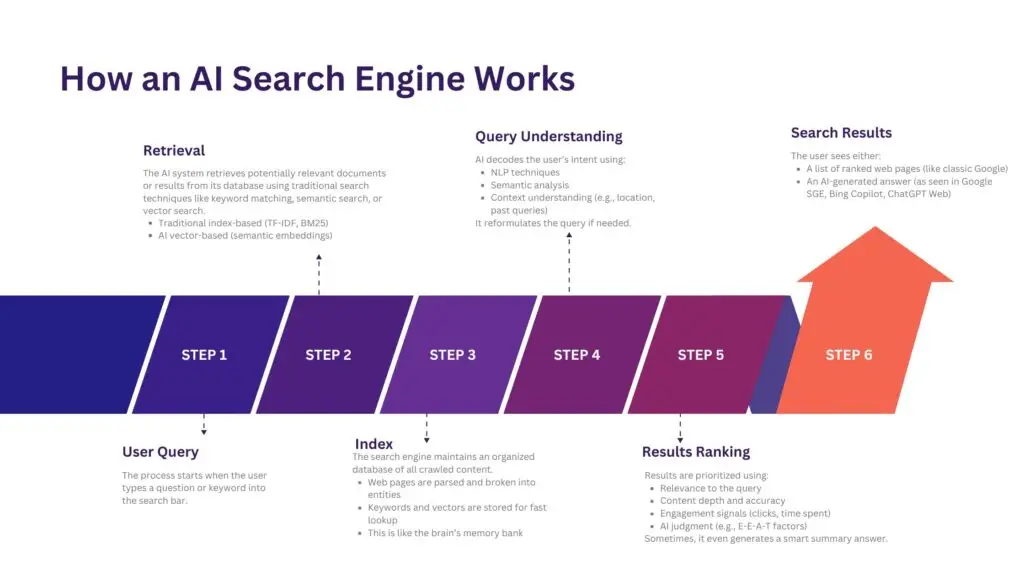Welcome to the era of AI Overviews, where search engines like Google, Bing, and Perplexity AI serve up direct answers instead of ten blue links.
For big brands, that might seem like an easy win. But for smaller teams, consultants, and indie creators, the question becomes:
How do I rank in AI when I’m not already everywhere?
The good news? AI doesn’t care about your brand size—it cares about how well you answer the user’s intent.
Whether you’re a founder optimizing your startup’s blog, an SEO expert testing new terrain, or a developer creating content-rich documentation, this guide will walk you through:
- How do AI Overviews work?
- What content and structure does AI prefer?
- Practical ways to appear in search, even without a big domain footprint
- Key mistakes to avoid
- Tools, schemas, and strategies that give you a competitive edge
This isn’t just another SEO checklist. This is your visibility playbook for the new AI-driven internet.
Let’s dive in.
What is AI Search & Why It Matters in 2025
In traditional SEO, your goal was to rank on page one. In 2025, your goal is to become the answer, because AI doesn’t wait for clicks.
Search has changed.
Tools like Google’s Search Generative Experience (SGE), Bing AI, Perplexity AI, and even ChatGPT with browsing now summarize answers from multiple sources in one conversational response. These AI Overviews are fast, rich, and frequently end the user’s search journey, without them ever having to click a link.
According to BrightEdge, over 60% of all searches now result in zero clicks.
This trend isn’t just happening on Google. Platforms like Perplexity cite sources directly in their answers. Bing highlights AI-summarized snippets. Even You.com and Brave Search are moving toward conversational delivery.
So, where does that leave you?
It means your content must be optimized not just for rank, but for recognition by AI engines.
Here’s how it works:
- AI models crawl and extract structured, well-written content
- They prioritize answers that are clearly formatted, semantically rich, and easily digestible.
- Content with schema, question-based sections, and trust signals stands a much higher chance of being featured.
The playing field has shifted, and unlike old SEO battles, you don’t need a massive backlink profile or a Fortune 500 logo to earn visibility in AI search.
You just need to answer better.
How AI Overviews Work: The Anatomy of an AI-Surfaced Result
When you search a question on Google or Bing in 2025, chances are you’ll get an AI-generated overview—a conversational answer pulled from multiple websites and stitched together in real time.
But how do these systems decide what to show?
Here’s what’s happening behind the scenes:
1. AI Detects Intent, Not Just Keywords
Unlike traditional search, AI engines like Google SGE and Bing AI interpret the underlying question, even if it’s phrased differently. This means your content needs to align with intent, not just keyword phrases.
2. It Extracts Structured, Semantic Content
AI looks for:
- Headings that resemble questions
- Concise, factual answers
- Lists, steps, definitions, and summaries
- Schema markup (like FAQPage, HowTo, TechArticle)
If your content is organized and well-structured, it’s far more likely to be selected as a source.
3. It Evaluates E-E-A-T (Experience, Expertise, Authority, Trust)
AI systems prefer content that’s backed by:
- Clear authorship and credentials
- Consistent topical coverage (clusters)
- Outbound and inbound links to reputable sources
These trust signals help generative models choose credible answers.
Want a full breakdown of AEO, schema strategies, and how to optimize for AI engines?
Don’t miss the Answer Engine Optimization Guide, packed with examples, schema code, and practical checklists.

6 Practical Strategies to Rank in AI Search (Even Without a Big Brand)
Just because you’re not a household name doesn’t mean you can’t be the best answer in AI search.
Here are six strategies that give your content a real shot at visibility in SGE, ChatGPT, Perplexity, and other AI-powered platforms.
1. Use Q&A-First Formatting
AI engines love content that mirrors how people search:
“What is schema markup?”
“How do I rank in AI search?”
Structure your blog with:
- H2/H3 headings framed as questions
- Short, direct answers below each heading
- Bulleted lists and step-by-step summaries
Why it works: AI Overviews use natural language processing (NLP) to extract snippets. Clear formatting makes your answer easy to lift and cite.
2. Add Schema Markup for Structure & Trust
Search engines rely on structured data to understand your content.
Add JSON-LD schema for:
FAQPage (for Q&A sections)
HowTo (for step-by-step guides)
TechArticle/BlogPosting (for authority signaling)
Bonus: You can grab copy-paste-ready templates from my GitHub schema library or the Google Rich Results Test tool.
3. Build Topic Clusters, Not Just Pages
One post won’t build authority, but five interconnected ones will.
Create clusters of content around a single topic (e.g., “AI Search Strategy”) with:
- Interlinking pages
- Consistent use of entity terms
- A pillar page (like this one on AEO)
This helps both humans and machines see you as a trusted source on that topic.
4. Write for Humans and Machines (a.k.a. Voice + AI)
AI engines favor conversational, natural language, not jargon-heavy walls of text.
What to do:
- Use shorter sentences
- Answer with clarity, not fluff
- Include questions people ask (tools: AlsoAsked, ChatGPT, AnswerThePublic)
Voice search overlaps heavily with AI search, so optimize for both at once.
5. Optimize Your Visuals for Multimodal Search
Google’s MUM model uses text, images, and video to understand context.
Here’s how to get your visuals AI-ready:
- Use descriptive file names (e.g., ai-search-example.png)
- Add detailed alt text with keywords and context
- Use “ImageObject” schema for featured images, charts, or infographics
This boosts visibility in Google Lens, Discover, and even SGE’s visual panels.
6. Demonstrate E-E-A-T Everywhere
You don’t need a Wikipedia page, but you do need trust signals.
Build E-E-A-T with:
- Author bios and bylines
- External citations to authority sources
- Internal links to related posts
- Up-to-date publishing and modification dates
- An About and Contact page for credibility.
Pro Tip: Use author, publisher, and Person schema to make your trustworthiness machine-readable.
Real Examples: Who’s Already Winning in AI Search?
Let’s look at how brands—both large and small—are already being featured in AI Overviews, and what you can learn from them.
Example 1: SurferSEO’s “How to Rank in AI Overviews”
Where it’s featured: Google SGE and Bing AI summaries
Why it works:
- Structured Q&A format using H2 questions
- Clear, concise definitions and step-by-step instructions
- Implements FAQPage and HowTo schema
- Author bio + updated publish date for E-E-A-T
Takeaway: Format your content like it’s a product manual for AI to read.
Example 2: WebFX’s AI Search Visibility Guide
Where it’s surfaced: Bing AI chat summaries + Google Discover
Why it works:
- Internal linking within a content cluster
- Voice-search friendly phrasing
- High content clarity and natural tone
Takeaway: Don’t underestimate tone and user-centric phrasing.
Example 3: A Personal Blog Featured in Perplexity AI
Where it’s shown: Perplexity citations for “AEO examples”
Why it works:
- Published using TechArticle schema
- Focused blog post on a long-tail query
- Links to Google Developer documentation as a trust signal
Takeaway: Even a blog on a small domain can surface if structured well.
What do all these examples have in common?
- Clear formatting
- Structured schema
- Author and topical authority signals
- Focused, high-value answers
Common Mistakes That Keep You Invisible in AI Search
Optimizing for AI search isn’t just about doing the right things, it’s also about avoiding the wrong ones. Many marketers unknowingly sabotage their visibility in AI Overviews and generative search by relying on outdated tactics or skipping technical fundamentals.
Here are some of the most common mistakes (and how to fix them):
1. Ignoring Structured Data (Schema Markup)
Many websites still skip schema markup, thinking it’s optional or only for developers.
Why it matters:
Google and other AI engines rely on structured data to understand the context and role of your content. Without a schema, your answers may be great, but invisible to machines.
Fix it:
Add FAQPage, HowTo, BlogPosting, or TechArticle schema to your content. Use Google’s Rich Results Test or tools like RankMath or Yoast to implement this easily.
2. Relying Solely on AI-Generated Content
AI writing tools are powerful, but raw AI content, without editing or formatting, can lead to generic, low E-E-A-T results.
Why it matters:
AI engines like SGE prioritize original, well-structured, and experience-driven content. If your content sounds robotic or unoriginal, it won’t cut.
Fix it:
- Add personal insights, real-world examples, and clarity.
- Combine AI assistance with human editing and semantic structuring.
- Layer your expertise on top of tools like ChatGPT or Jasper.
3. Focusing Only on Clicks, Not Impressions
Many SEO people are still obsessed with click-through rates (CTR), but in the world of zero-click search, visibility is the new currency.
Why it matters:
AI Overviews may not drive direct clicks, but they build brand recall, top-of-mind presence, and authority perception.
Fix it:
- Track your content’s “impression value” using GA4 and Search Console.
- Monitor your featured snippet appearances and People Also Ask citations.
- Utilize analytics to track AI-generated impressions as potential conversions.
4. Outdated Formatting and Over-Optimization
Walls of text, keyword stuffing, and over-optimized H1s are a thing of the past.
Why it matters:
AI engines prefer natural language, conversational tone, and helpful formatting, just like human readers.
Fix it:
- Use shorter paragraphs, bullet points, and clear subheadings
- Prioritize readability, scannability, and flow
- Write like you’re answering a question in a live conversation
5. Missing Author or Credibility Signals
Many small blogs lack author bios, publishing dates, or links to reputable sources.
Why it matters:
These are E-E-A-T indicators. AI engines use them to assess whether the content is trustworthy and authoritative.
Fix it:
- Add an author bio with credentials or experience.
- Include publication and update timestamps.
- Cite authoritative sources (Google, HubSpot, Moz, etc.) in your content.
Future-Proofing: What Comes After AI Overviews?
AI Overviews are just the beginning. As search engines continue to evolve, content creators and marketers need to stay ahead of the next wave: multimodal, hyper-personalized, and generative-first search experiences.
Here’s what’s coming — and how to stay ready:
1. GEO and LLM-O: Generative Optimization is the New SEO
You’ve heard of SEO. Now say hello to GEO (Generative Engine Optimization) and LLM-O (Large Language Model Optimization).
These emerging concepts focus on optimizing content specifically for how LLMs consume, summarize, and synthesize answers, not just how search engines index them.
How to adapt:
- Emphasize clarity, accuracy, and factual support
- Use question-driven formatting and structured data
- Treat every section as a possible standalone answer
2. Voice Search Is Now Mainstream
With the rise of smart assistants, mobile browsing, and screenless devices, voice search now accounts for over 25% of all searches.
Future-proof tip:
- Write content that sounds natural when read aloud
- Use tools like ChatGPT’s voice mode or Google’s text-to-speech preview
Implement the Speakable schema for high-authority content blocks
3. Multimodal Search Is Already Here
Google’s MUM model allows AI to process text, image, and video inputs together, and it’s being rolled out across Discover, Lens, and even AI Overview panels.
How to stay ahead:
- Use descriptive image alt-text
- Add video transcriptions and visual summaries
- Label your visual content with captions + ImageObject schema
4. Your Brand Is an AI Ranking Signal
LLMs increasingly factor in who is saying something, not just what’s being said.
This means your:
- LinkedIn presence.
- Author bio schema.
- Relevance across web properties.
Future-proof tip:
Strengthen your personal brand across all platforms. Get cited, contribute to publications, and link everything together with schema.
You Don’t Need to Be Big—You Need to Be the Best Answer
AI-powered search has changed the rules.
You don’t need 10,000 backlinks. You don’t need to be a Fortune 500 brand.
What you do need is clarity, structure, and credibility.
If your content:
- Speaks directly to search intent
- Is formatted with Q&A logic?
- Uses schema to structure context
- Demonstrates real experience and authority
💬 In 2025 and beyond, visibility belongs to those who explain best, not just those who rank first.
So what’s your next move?
If you are a developer and want to rank your content over AI, you should read this.
From Dev Blog to AI Discovery – How to Rank Your Content in Generative Search

Mayank Ranjan
Mayank Ranjan is a digital marketing strategist and content creator with a strong passion for writing and simplifying complex ideas. With 7+ years of experience, he blends AI-powered tools with smart content marketing strategies to help brands grow faster and smarter.
Known for turning ideas into actionable frameworks, Mayank writes about AI in marketing, content systems, and personal branding on his blog, ranjanmayank.in, where he empowers professionals and creators to build meaningful digital presence through words that work.








